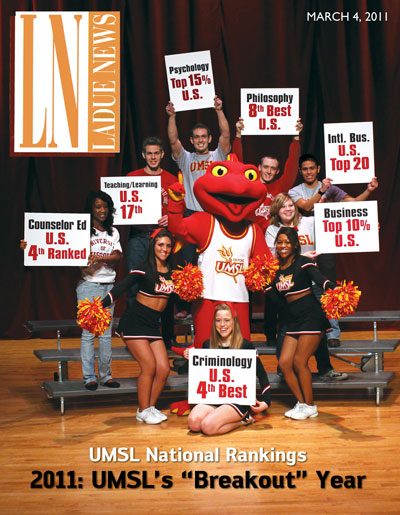
The March 4 cover of Ladue News is just one component of the university’s integrated recruitment and image marketing campaign currently underway.
Serious education. Serious value. And now serious marketing.
The University of Missouri–St. Louis has launched an integrated marketing campaign to support student recruitment, image development, and, to a degree, fundraising. The campaign combines traditional marketing and advertising techniques with emerging social media and Web strategies. The results thus far have been dramatic – increased web responses, recruitment event attendance, inquiries to the admissions office for information and, most important, applications.
Unlike any effort undertaken by UMSL in the past, the current integrated marketing campaign is the brainchild of Senior Associate Vice Chancellor and Chief Marketing Officer Ron Gossen, a veteran advertising, marketing and public relations executive who was recruited to UMSL in July.
“Most marketers are handed chopped liver and asked to sell it as steak,” Gossen says in explaining UMSL’s marketing efforts. “But I’m fortunate. UMSL is a great institution. I’ve been given steak and asked to turn up the heat and get it sizzling.”
The sizzle includes a simple, but well-researched tagline: Serious education. Serious value.
“As a research university, UMSL faculty are serious about the academic mission,” Gossen says. “Likewise, it’s important to understand that value is not the same thing as cheap, or even affordable, rather value is the relationship of quality to cost. UMSL academic quality is, in many respects, far superior to many of the other universities in the region. But, the cost of a quality UMSL education is about half. By definition, that’s value, serious value.”
Getting more people to understand and act on that message is the heart of the campaign. UMSL began running radio, outdoor and print advertisements, as well as word-search advertising on Google and other search engines in February. The media selected and targeted messaging was directed to potential freshmen and transfer students, as well as parents and other influencers. The advertisements drive listeners to custom micro sites – individualized Web sites designed to give students and parents the specific type of information they need to determine if UMSL is right for them.
Early returns are promising, if UMSL Day is any indication. University Marketing and Communications produced radio, web, search and print advertisements to drive audiences to a micro site for UMSL Day – an open-house-like event held by the admissions office. UMSL Day this spring attracted 632 registrants as compared to 369 in spring 2010.
Billboards touting UMSL’s advantages also started appearing in February along Interstates 70, 170, 44 and 64 in Missouri and Illinois. The messages are seen by nearly a half-million viewers daily. The board locations and messages will rotate monthly through August.
Gossen has been meeting with various groups on campus to explain UMSL’s marketing efforts. He’s also created a Marketers Forum consisting of communications professionals in colleges, schools and other units across campus to discuss strategy, message consistency and to craft joint-marketing efforts. The reception thus far, he says, has been very positive.
“I have yet to meet anyone who does not believe that UMSL needs to do more to promote itself,” Gossen says. “And they seem genuinely appreciative of our efforts to lead this transformation.”
Among those transformative issues is UMSL’s Web and social media presence. Information Technology Services and University Marketing & Communications have forged a partnership that transferred responsibility of public Web content and strategy to the marketers. ITS will retain responsibility for Web security and integrity. Similarly, University Marketing & Communications has embarked on an integrated social media policy and platform that integrates and supports the activities of the university, colleges, schools and units on Facebook, Twitter, and You Tube, among others.
Gossen concludes that “UMSL has earned prestigious academic recognition. Our alumni are the drivers of St. Louis. We are a wholly engaged positive force for the betterment of the community. It’s our job to ensure that the University of Missouri–St. Louis receives its due.”














